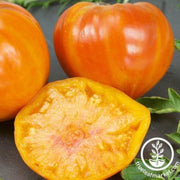Out Of Stock!
We will notify you when this product becomes available.
Tomato Seeds - Slicing - Patty's Striped Beefsteak
85 Days to maturity (from transplant). Solanum lycopersicum. Patty’s Striped Beefsteak Tomato Seeds. Non-GMO, warm season annual, open-pollinated, heirloom, indeterminate, slicing tomato. Suitable for growing in garden plots, raised beds, greenhouses. Tomato Patty's Striped Beefsteak is extremely attractive and sweet with very little acid. Approximately 6,800 seeds/ounce.




Download Free Vegetable Growing Guide PDF
Growing Patty's Striped Beefsteak Slicer Tomatoes in the Vegetable Garden
Growing tomatoes from seed is a rewarding journey that starts with selecting quality seeds. Begin the process 7-9 weeks before the last expected frost by planting seeds in a well-draining seed-starting mix at a depth of approximately 0.25 inches. Maintain moisture and provide adequate light, either through natural sunlight or artificial sources like grow lights, to support healthy germination.
As the tomato seedlings develop, ensure they receive at least 12-16 hours of light per day and rotate the tray to prevent leaning towards the light source. When the seedlings reach around 2 inches in height and develop true leaves, it's time for their first transplant. Gently transfer each seedling into larger containers filled with nutrient-rich potting soil, choosing containers with proper drainage to avoid waterlogging. Growing tomatoes in containers is a versatile option for those with limited space. Use large containers with good drainage, fill them with quality potting mix, and transplant seedlings when they outgrow their initial containers. Provide ample sunlight and support structures like stakes or cages as the plants mature.
Before planting, test the soil for pH and nutrient levels to create optimal growing conditions. Tomatoes prefer slightly acidic soil with a pH range between 6.0 and 6.8. Implementing a crop rotation strategy is crucial to prevent soil-borne diseases, avoiding planting tomatoes in the same location as the previous year. Throughout the growing season, regular pruning helps manage plant vigor and increase air circulation, reducing the risk of diseases. Fertilize the plants regularly with a balanced fertilizer following package instructions. Companion planting can enhance tomato growth; consider planting basil, marigolds, or nasturtiums nearby to deter pests and improve flavor. Incorporate these steps into your tomato-growing journey for a successful and bountiful harvest. Regular monitoring and adjustments based on the plant's needs contribute to a thriving tomato cultivation experience.
Harvesting Patty's Striped Beefsteak Tomatoes
Harvesting beefsteak tomatoes is a straightforward process. Once the fruits have reached their mature size use a sharp pair of pruning shears or scissors to cut the tomatoes from the vine, leaving a short stem attached. Be careful not to bruise or damage the fruit during harvesting. After harvesting, store beefsteak tomatoes at room temperature until fully ripened. If you have a surplus of ripe tomatoes, they can be stored in the refrigerator for a short period to slow down the ripening process.
About Heirloom Patty's Striped Beefsteak Tomato Garden Seeds
Patty’s Striped Beefsteak tomato plants are indeterminate. Indeterminate tomato plants are characterized by continuous growth and fruit production throughout the growing season. Their vining habit requires sturdy support, and pruning can optimize yields and manage space.
Beefsteak tomatoes are characterized by their large size, meaty texture, and robust flavor. With few seeds, they're ideal for slicing and are often used in sandwiches and salads for their juicy goodness.
Tomato Patty's Striped Beefsteak is beautiful and sweet with very little acid. This plant produces beautiful yellow fruits with thin red and pink stripes on the skin. The fruit's interior is also golden yellow and has red striping within. Grow Patty's Striped Beefsteak this summer for delicious 5-6 ounce tomatoes.
Regular monitoring for early signs of pests or diseases, coupled with cultural practices like proper spacing and crop rotation, forms a holistic IPM strategy that minimizes environmental impact and promotes the long-term health of tomato crops.
The Patty's Striped Beefsteak tomato variety has an intriguing origin that traces back to traditional heirloom tomato breeding. Heirloom varieties like Patty's Striped Beefsteak are often cultivated for their unique characteristics, flavor profiles, and historical significance. These tomatoes have likely been passed down through generations of gardeners who appreciated their distinct appearance and delicious taste. The specific origins of Patty's Striped Beefsteak may not be precisely documented, as heirlooms often have rich histories rooted in local communities and family gardens, contributing to their charm and popularity among tomato enthusiasts.
Tomatoes are a nutritional powerhouse packed with vitamins, minerals, and antioxidants. Rich in lycopene, a potent antioxidant, tomatoes contribute to heart health and may reduce the risk of certain cancers. Cooking tomatoes enhances lycopene absorption, making sauces, soups, or roasted dishes an excellent choice for maximizing their nutritional benefits. Consuming tomatoes supports overall well-being, providing essential nutrients for a healthy diet.
Tips From Our Gardeners
"Make the most of a large tomato harvest by preserving the fruit for later consumption. Eat as many as you want fresh and then can, freeze, freeze dry, or otherwise preserve your tomatoes. Tomatoes store remarkably well and make a wonderful mid-winter addition to recipes! Check out my Instant Pot tomato sauce recipe post for an easy way to preserve fresh tomatoes."
 |
- Lara Wadsworth, True Leaf Market Writer |
Other Resources
Patty's Striped Beefsteak Tomato Seeds Per Package:
- 300 mg packet - Approximately 65 Seeds
- .25 oz - Approximately 1,700 Seeds
- 1 oz - Approximately 6,800 Seeds
- 4 oz - Approximately 27,200 Seeds
- 1 lb - Approximately 108,800 Seeds
Non-GMO Patty's Striped Beefsteak Tomato seeds are available for Fast Free Shipping on qualifying orders.
Basic Info
| Latin Name: | Solanum lycoperscium (previously Lycopersicon esculentum) |
| Tomato Type: | Slicing - Larger, round tomatoes, the size of your fist or larger. |
| Patty’s Striped Beefsteak Tomato Color: | Orange, Yellow |
| Patty’s Striped Beefsteak Tomato Flavor: | Sweet, little acid |
Growing Info
| Hardiness Zone: | 2, 3, 4, 5, 6, 7, 8, 9, 10, 11 Annual: Not intended to overwinter |
| Days to Maturity: | 85 (from transplant) |
| Days to Germination: | 7-10 |
| Seeding Depth: | 0.25 inch |
| Plant Spacing: | 24-36 inches |
| Row Spacing: | 36 inches |
| Plant Height: | 36-48 inches |
| Growth Habit: | Indeterminate - Indeterminate tomatoes are vine-type plants that sprawl (requiring a cage or trellis to support them) and continue to grow throughout the season. Indeterminate tomato plants will continue to produce tomatoes for the rest of the season, so you can harvest continually. |
| Soil Preference: | Well-draining, loose (sandy loam), slightly acidic (6.2 to 6.8), and moisture retaining. Too much nitrogen in the soil may lead to more foliage production and less fruiting. Tomatoes like more phosphorus and potassium than other vegetables. |
| Temperature Preference: | Warmer (70-85 F) |
| Light Preference: | Full Sun |
Other
| Direct Sow: | No |
| Start Indoors: | Yes. Start Indoors 7-9 weeks before your last spring frost date. |
| Plant Width: | 24 inches |
| Plant Spread: | 24 inches |
| Growth Speed: | Late - Ready to harvest from 81 days or more from transplant. Difficult, if not impossible, to get a tomato by the 4th of July with these varieties. They are good late-summer to early-fall producers for most USDA Zones. |
| Germination Temperature: | 65-85 F |
| Pests and Diseases: | Common pests known to harm tomato plants, in general, include the tomato hornworm, cutworm, aphids, flea beetles, tomato fruit worms, and whiteflies. Also, watch for common diseases such as blossom end rot, fusarium wilt, powdery mildew, verticillium wilt, late blight, bacterial canker/spot, and tobacco mosaic virus. Most of these can be prevented by maintaining a regular watering schedule and avoiding overwatering. Regularly check your plants for pest damage throughout the season. For treating pest and disease problems, we recommend using an organic neem-based product. |
| Garden Size: | Greenhouse, Garden Plot, Raised Bed |
| Tomato Use: | Salads, fresh eating, slicing |















